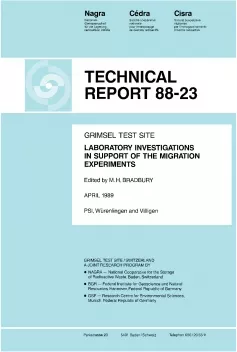
Technical Report NTB 88-23
Grimsel Test SiteLaboratory investigations in support of the migration experiments
Tracer migration experiments are in progress at the underground Grimsel Test Site (GTS). In order to interpret field tracer tests a supporting laboratory experimental programme is essential. This report describes the results from the first part of such a programme.
Insufficient material from the protomylonite surrounding the fracture was available from the migration site (AU 96) for the foreseen experiments and so mylonite from an adjacent fault zone (AU 126) was used instead. Detailed petrographic and mineralogical characterisations of the protomylonite and mylonite were carried out. The mylonitic samples from these two sources were shown to be mineralogically similar although some potentially significant differences did exist. The protomylonite was slightly depleted in those minerals (chlorite, muscovite etc.) which could be significant for sorption/exchange processes. This may have consequences for predictions of the sorption behaviour in the migration zone deduced from laboratory measurements.
The fracture zone (AU 96) exhibited groundwater discharge at five discrete channels situated in a single fracture. Groundwater emerging from these five locations, and from two boreholes intersecting the plane of the fracture, were sampled and analysed at approximately monthly intervals over a period of 12 months. The results showed that there were no significant temporal or spatial variations in the compositions. This groundwater may be characterised as being of low ionic strength (~ 10-3 M), high pH (~ 9.6) with Na+, Ca2+, CI-, SO42-, F- and HCO3- as the major ions. The partial pressure of CO2 calculated to be in equilibrium with the groundwater was ~ 4 × 10-6 bar.
A series of mylonite – groundwater interaction experiments using natural and synthetic Grimsel groundwaters were carried out at two solid to liquid ratios (1:2 and 1:10) and two temperatures (ambient temperature ~ 25°C and field temperature, ~ 12°C) for times of up to 200 days. Even though the systems became contaminated with carbon dioxide (from the atmosphere) at a relatively early stage, it was nevertheless found that the changes in water compositions and the behaviour of the solid phase in these experiments could be quantitatively understood by considering the mylonite as a (weak) cation exchange medium.
On the basis of the measured cation exchange capacity (CEC) and the exchangeable cations on the mylonite, sorption coefficients for Na, Sr, Ca and Mg could be deduced. Further, estimates of sorption coefficients for these ions under conditions likely to exist in the migration tests were made.
Finally, proposals for a number of potentially useful sorbing tracers in the second series of field migration experiments are given together with the conditions under which they are predicted to behave as "ideal" sorbing tracers i.e. exhibiting equilibrium linear reversible sorption with rapid kinetics.
